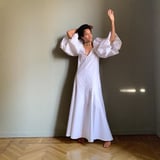
The term "house dress" originated in the late 19th century and gained popularity in the early 20th century, and described a frock designated for doing chores around the house or running errands. It was by no means presentable enough to travel in or wear to a function; but in the 1950s, these became progressively more stylish. House dresses were part of the daily uniform, many coming as part of a set with matching aprons or gloves, in floral and gingham prints, or with pockets.
But in 2020, all the house dress really means to me is something functional, yet romantic that is also comfortable (think: poplin or linen fabric in loose silhouettes or a breezy shirtdress). These dresses also have details like pouf sleeves, embroidery, or frilled skirts that make them stylish enough on their own without even a pair of shoes. I don't want to say they were made for your next stay-at-home photo shoot, but I mean, weren't they?
At its core, the house dress is just the laid-back, lovable look you reach for when you're tired of your sweats and you want to dress up a little bit. The style is even being referred to as the "house dress" by some of our favorite brands and leaders in fashion, and at least one pops up on my Instagram feed every day - so that's how you know it's a trend.
I've been sifting through my wardrobe in search of my own house dress, and though I did find one peach midi with a removable tie-sash waist and balloon sleeves from Zara, I can't say I'm not interested in the new iterations that are available. Ahead, check out the vibes of this 2020 house dress I speak of, and then shop a few of my personal favorites - all of which can easily be worn with a pair of slides or chunky sneakers later on.
0 comments:
Post a Comment